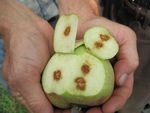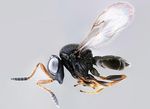Redistributing the samurai wasp in Virginia: Toward improved biological control of brown marmorated stink bug
←
→
Page content transcription
If your browser does not render page correctly, please read the page content below
Redistributing the samurai wasp in Virginia:
Toward improved biological control of brown marmorated stink bug
Brown marmorated stink bug (BMSB) (Fig. 1) is an invasive pest from Asia that feeds on a wide range of
wild and cultivated plants. Since its initial major outbreak in the Mid-Atlantic region in 2010, BMSB has
spread to many states, and its feeding injury to tree fruit crops such as apples and peaches has been
especially problematic (Fig. 2). BMSB has significantly disrupted the pest management programs
traditionally used by tree fruit producers, particularly because it occurs throughout the landscape and
moves into crops from wild host plants in adjacent woodlands during much of the growing season.
Consequently, there is considerable interest the role of biological control on BMSB suppression in
managed and unmanaged habitats in the USA.
Figure 1. BMSB adult (left) and nymph (right) on peach fruit
Figure 2. Internal feeding injury from BMSB to apple (left) and peach (right) fruit
Biological control is the combined actions of other organisms (often other insects) against a pest via
predation or parasitism. In their native range, invasive pests typically have one or more biocontrol
agents, also called natural enemies, that impact their populations. However, because these pests often
arrive in the invaded area in the absence of their “native” natural enemies, their populations can quickly
increase to levels that become difficult to manage. In the USA, certain species of predatory and parasitic
insects do attack BMSB eggs and/or nymphs, but their combined effects have not yet suppressed its
populations adequately.In Asia, the samurai wasp (Fig. 3) is considered one of the main natural enemies of BMSB. Laying its eggs in BMSB eggs (Fig. 3), its developing larvae feed on and kill the BMSB egg. Although the samurai wasp was not previously known to occur in the USA, it was detected in 2014 during natural enemy surveys in Maryland and has subsequently been detected in numerous other states and regions where tree fruit production occurs, including Frederick County, VA in 2015. While our initial surveys yielded samurai wasp detections in Frederick County, none were detected elsewhere in Virginia, prompting the question of whether this important, new BMSB natural enemy could be released and redistributed elsewhere in the Commonwealth. Figure 3. Adult female samurai wasp (left; photo credit Elijah Talamas) and female samurai wasp laying eggs in BMSB eggs (right; photo credit Chris Hedstrom) With approval and funding from the Virginia Department of Agriculture and Consumer Services, 10 sites between northern and southwest Virginia that spanned most of the major tree fruit production regions were selected strategically for samurai wasp releases (Fig. 4). Figure 4. Virginia sites at which samurai wasps were released in 2018 and 2020 and where it and BMSB were monitored in 2018, 2019, and 2020 Pre-release sampling in June 2018 yielded only 1 samurai wasp detection from the county closest to Frederick County. Wasps were released by deploying parasitized BMSB egg masses (Fig. 5) at all sites in late June and late July, 2018.
Figure 5. Screened release cage containing a BMSB egg mass parasitized by samurai wasp (in center of
white card attached to protective plastic dish). Adult wasps emerge from these eggs, mate, and then
disperse from the cage.
Post-release sampling in August 2018 yielded no detections, but sampling for BMSB using pheromone
traps at all sites in August and September showed substantial BMSB populations (Fig. 6), which seemed
to bode well for its establishment, particularly given the numbers of nymphs captured, which reflect the
numbers of BMSB eggs in the vicinity of traps.
600
Adults
500
Total BMSB captures
Nymphs
400
300
200
100
0
1 2 3 4 5 6 7 8 9 10
Site #
Figure 6. Captures of BMSB adults and nymphs in pheromone traps at the 10 samurai wasp release sites
in Virginia, August 2018.
Each year since, with the assistance of Virginia Cooperative Extension personnel at some sites, sampling
for samurai wasp and BMSB has occurred at all sites for several 3-week intervals from June through
September. In 2019, samurai wasps were captured at 4 sites, including the one from which it had been
detected in 2018, providing an encouraging suggestion of its potential establishment. In 2020, however,
despite a third release at all sites in July, samurai wasps were detected at only 2 sites, including that at
which it was detected in both 2018 and 2019 and one at which it was detected in 2019.Releasing and redistributing non-native natural enemies in new locations, known as classical biological control, is sometimes but not always successful at promoting the establishment, growth, and natural spread of the agent, and typically occurs under numerous assumptions. While our 2020 results were disappointing, there are many factors that may have influenced them. The worst scenario would be that it is failing to establish, although the abundance of BMSB at these sites tends to favor its establishment. Alternatively, it may be that the elapsed time since its release has not been sufficient for the wasp populations to build to detectable levels, based on our sampling method. Regardless, sampling for both samurai wasp and BMSB will continue in 2021, in hopes that further evidence of its establishment will be forthcoming and that, in the fullness of time, samurai wasp will impact BMSB populations in Virginia as it does in its native Asian range. For more information on BMSB and the samurai wasp, see stopbmsb.org.
You can also read
























































